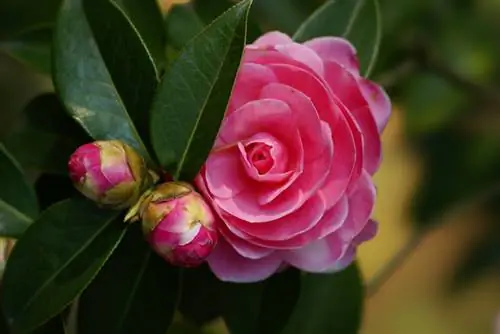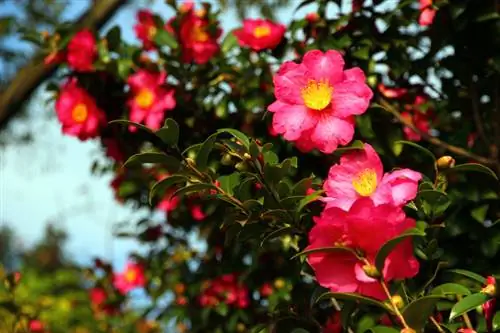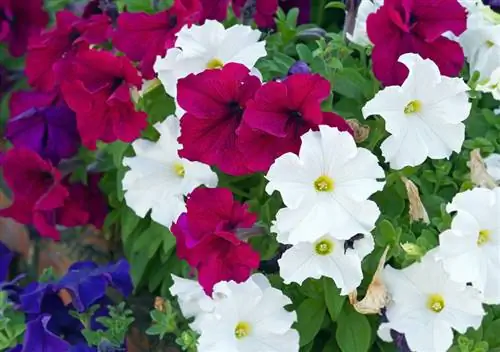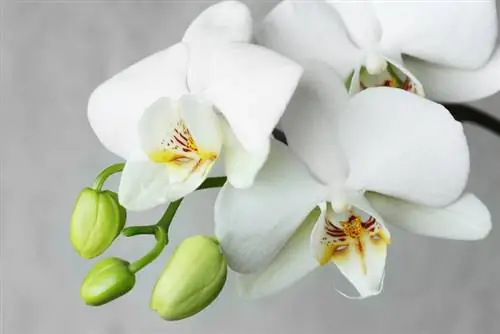- Author admin [email protected].
- Public 2023-12-25 17:45.
- Last modified 2025-01-23 11:22.
She has a reputation for being tricky to care for. In fact, the camellia is by no means capricious as long as significant aspects of its cultivation are taken to heart. The following answers to basic questions provide an overview of what these are.
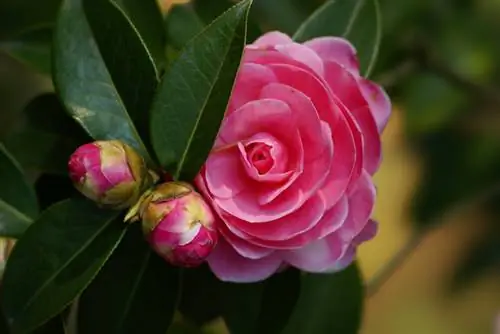
How do I properly care for a camellia?
To successfully cultivate a camellia, it should be planted in a partially shaded, protected location and regularly supplied with lime-free water and rhododendron fertilizer. Hardy varieties can overwinter outdoors with appropriate protective measures.
Planting camellia correctly
Camellia japonica has proven itself to be the ideal camellia for the garden. From the age of 4, this species has established itself so well that it can withstand the rigors of a winter and can withstand temperatures of up to -15 degrees Celsius in a protected location. The best time to plant an outdoor camellia is in April. In these steps the planting is completely successful:
- Dig a planting pit with twice the volume of the root ball
- Create a drainage system at the bottom of the pit made of inorganic, lime-free materials
- Mix the excavation with rhododendron soil, compost and a little sand
- Fill in the substrate to insert the potted Camellia japonica into it
The soil mark on the camellia indicates the ideal planting depth. Before watering, spread a protective layer of mulch. A mixture of leaves, straw and compost is perfect for this purpose. If you plant several camellias next to each other, consider an expected growth width of up to 180 centimeters when measuring the planting distance.read more
Care tips
Key positions in the professional care of a Camellia japonica are an adequate water supply and a balanced nutrient balance. That's what matters:
- Never let a camellia dry out
- If the substrate dries, water it with lime-free water
- Spray regularly with lukewarm rainwater during the growth phase from May to July
- From the end of May to mid-July, fertilize weekly with rhododendron fertilizer (€8.00 on Amazon) in half concentration
- Cleaning out faded flowers regularly attracts more flowers
To encourage lush branching, cut back a young Camellia japonica a little immediately after flowering. The cut is made about 2 cm above a bud so that it does not dry out. If an older specimen develops a sparse appearance, bring the ornamental tree back into shape by pruning.
Which location is suitable?
A careful choice of location sets the course for the successful cultivation of a Camellia japonica. The greatest danger to the flowering tree is late frosts. Therefore, both camellias in the pot and in the bed should be placed in a protected place, for example on a wall or pergola. These site conditions offer ideal conditions for lavish flowering and vital growth:
- Partly shaded lighting conditions with sunshine in the afternoon
- Protected from strong winds and pelting rain
- Nutritious, humus-rich, well-drained soil
- A slightly acidic pH of 5 to 5.5
For a Camellia japonica to bloom, a period of cold is required. If you mean too well and place the camellia in a warm living room or intensively heated winter garden, you will look in vain for a flower. At constant temperatures between 6 and 10 degrees, the buds unfold for a flowering period that lasts up to 6 weeks.read more
When is flowering time?
The flowering period of a Camellia japonica extends from February/March to April/May. In a mild winter, this species of camellia delights us with its magnificent blooms from January onwards. If the cultivation conditions meet your expectations, the Japanese camellia will bloom continuously for up to 6 weeks.read more
Watering camellia
Watering a camellia correctly requires a bit of sensitivity. On the one hand, the root ball should be constantly moist, but on the other hand, waterlogging proves to be absolutely fatal. In addition, the conditions at the site determine the water requirements. A Camellia japonica placed in a sunny location evaporates a greater amount of moisture than a camellia in a shady, cool location. How to water properly:
- Water abundantly and thoroughly from spring to autumn
- If the thumb sample shows a dry substrate surface, watering is carried out
- Use collected rainwater, pond water or decalcified tap water
- During the growing months of May to July, spray additionally with lukewarm water every few days
- It's better to water intensively once a week instead of a little every day
- Pour out a bucket coaster after 20-30 minutes at the latest
In winter the water requirement is reduced without coming to a complete standstill. At this time of year it is important to avoid the root ball drying out completely. This premise applies equally to Camellia japonica in beds and containers. If the winter comes with frost and there is no snow in the freezing temperatures, water your camellias on a frost-free day.read more
Diseases
The camellia got its reputation as a sensitive flower diva because it sometimes drops its flowers. However, this damage is due to neglect in care. In fact, Camellia japonica in particular proves to be robust and resilient. If he alth problems arise, the camellia plague is usually behind it. This is the fungal infection Ciborinia camelliae, which can be recognized by the following symptoms:
- The sticky fungal spores only affect the flowers
- Where the mycelium takes root, it germinates very quickly, the flower turns brown and falls off
- The fungi die on the leaves or shoots without causing any damage
An effective control agent has not yet been discovered. At the first sign of infection, the affected petals are cut off and disposed of with household waste. Under no circumstances do the spore carriers migrate to the compost because they spread further from here.
Repotting
The leisurely growth rate of a camellia only requires changing to a larger pot every 2 to 3 years. Only when the roots push through the substrate is it repotted. The best time for this measure is immediately after flowering in spring. How to do it right:
- The new pot is a maximum of 5-6 centimeters larger in diameter
- Spread a drainage system made of potsherds or expanded clay over the water drain in the ground (no calcareous gravel)
- Fill in fresh ericaceous soil up to half the height of the pot
- Now unpot the Camellia japonica and place it in the middle of the new pot
- Plant exactly as deep as it was previously in the planter and water it
We recommend placing an air and water permeable fleece between the drainage and the substrate. This prevents soil crumbs from clogging the material. If you prefer your own mixtures as potting soil, the following recipe has proven to be effective: a third each of garden soil, peat and compost, enriched with a little sand for good permeability.read more
Is the camellia hardy?
The extent to which a camellia is winter hardy is controversially discussed among experts. The fact is that the Camellia japonica species in particular can survive a winter outdoors with good care and appropriate precautions. In regions with mild winters or in a protected, partially shaded to shady location, a camellia proves to be hardy with the help of these protective measures:
- Hill up with a layer of at least 20 cm thick of leaves, straw, bark mulch and compost
- A tent-shaped windbreak made of reed mats or coniferous branches, padded with leaves
- A cover made of jute or garden fleece
- Wrap a bucket thickly in bubble wrap and place it on wood or Styrofoam
It's not so much the cold that causes winter damage to a Camellia japonica. Instead, the ornamental tree should be protected from the blazing morning sun in winter, as it causes considerable damage to the buds that have already formed and dries out the lush green foliage.read more
The most beautiful varieties
- Debbie: a Camellia japonica with lush double flowers in bright pink
- Mary Williams: the noble variety for the winter garden impresses with semi-double, pink-red flowers and bushy habit
- Bonomiana: breathtaking ornamental tree whose pink-red striped flowers contrast with evergreen leaves
- White Swan: conditionally hardy camellia with semi-double, bright white flowers
- Adolphe Audusson: impresses with its robust frost hardiness and deep red, semi-double flowers up to 13 cm in diameter
- Barbara Clark: a delicate camellia beauty whose delicate pink flowers bloom from January to April
- Caryophylloides: an English classic from 1848, whose pink flowers are marked dark red
- Chameleon: presents the semi-double, light red flowers from March to May
- New Dawn: an autumn-blooming camellia from France with wavy pink petals from October
- Narumigata: unfolds white flowers in the winter garden from October to January

